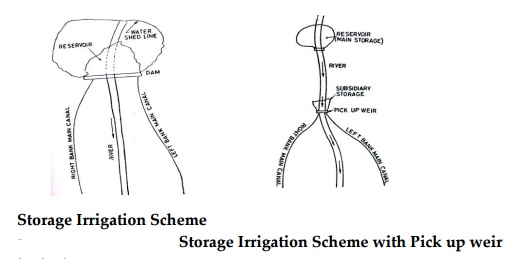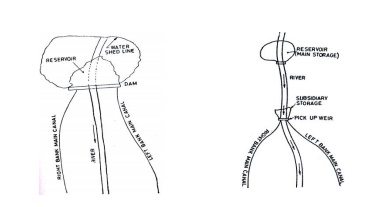Chapter: Civil : Water Resources and Irrigation Engineering : Irrigation Engineering
Distribution System for Canal Irrigation

Distribution System for Canal Irrigation:
It has been emphasized earlier that the direct irrigation scheme using a weir or a barrage, as well as the storage irrigation scheme using a dam or a reservoir, require a network of irrigation channels. The entire network of irrigation channels is called canal system. The canal system, as explained earlier , consists of:
1. Main canal
2. Branch canals
3. Distributaries
4. Minors, and
5. Watercourses
In case of direct irrigation scheme, a weir or a barrage is constructed across the river, and water is headed up on the upstream side. The arrangement is known as Head Works or Diversion Head Works, and will be explained in details, a litter later, in chapter. Water is diverted into the main canal by means of a diversion weir. A head regulator is provided at the head of the main canal, so as to regulate the flow of water into the main canal.
In storage irrigation scheme, a dam is constructed across the river, thus forming a reservoir on the upstream side of the river. The water from this reservoir is taken into the main canal through the outlet sluices. There are generally two main canals, which off â€'take from the reservoir, called the Left Bank Canal and the Right Bank Canal, as shown in figure.
In certain storage irrigation schemes, commanded irrigation area may be far away from the dam site. In such cases, a separate head works consisting of a pick â€'up weir, is constructed across the river on the downstream side of the main dam, at a point where the commanded area begins. The main canal, in such a case, will off â€'take from the upstream side of the weir, just as in a normal diversion weir scheme. This arrangement is shown in figure.

Figure: Storage Irrigation Scheme Figure: Storage Irrigation Scheme with Pick up weir
In both these irrigation scheme, when once the water reaches into the main canal, the problem left is to distribute this water into the fields. The purpose is achieved through a network of channels, as described below:
(a) Main Canal (Head reach): The canal head works are generally situated in a valley, and the canal should mount the watershed in the shortest possible distance. The canal, in this reach, must be aligned very carefully and has to be generally excavated in deep cuttings below N.S.L. (natural surface level). Sometimes, it has to cross various drainage lines. Many a times, straight alignment has to be sacrificed in order to achieve a good site for cross drainage works.
(b) Main Canal (Portion below head reach): Attempts are made to align the canal along the watershed and somewhat central to the commanded area. Sometimes, water â€'shed has to be sacrificed to bypass towns and villages, etc. Main canal is not required to do any irrigation.
(ii) Branch Canals: When a main canal leaves the high ground and must, therefore, bifurcate into branches, covering the whole tract required to be irrigated, the canals in such portions are called Branch Canals. Very little irrigation is done from the branch canals. Attempts are made to align them along subsidiary water â€'sheds. Discharge in a branch channel, is generally, more than 30 cumecs.
(iii) Distributaries: Smaller channels which take off from the branch canals and distribute their supply through outlets into minors or water courses, are called distributaries. They are aligned either as watershed channels or as side slope channels. Discharge in a distributaries is generally less than 30 cumecs. Minors: Sometimes, the country is such that the distance between the distributary outlet and the farmer’s field is very long; say more called minors, are taken off from the distributaries, so as to supply water to the cultivators at the
point nearer to their fields. Discharge in a minor, is generally, less than 2.5 cumecs.
(v) Watercourses: These are not the government channels and belong to the cultivators. These are small channels, which are excavated by cultivators, to take water from the government â€' owned outlet point provided in the distributary or the minor.
Related Topics